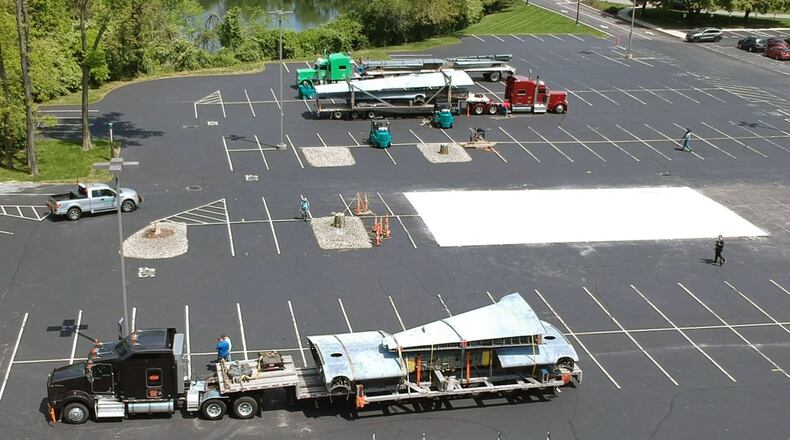The plane’s fuselage and other parts are scheduled to arrive this afternoon. In coming weeks, a barrier will be erected and a hangar will be built, sheltering the plane and the research.
Keeping older planes flying, and doing so in a cost-effective manner, is one of the Air Force’s bigger challenges. New technologies such as additive manufacturing — sometimes called “3-D printing” — offer the Air Force a relatively low cost way to replicate older plane components.
Once reassembled, researchers from UDRI will work with the Air Force Life Cycle Management Center Product Support Engineering Division and the center’s C-130 program office, both based at Wright-Patterson Air Force Base.
Wright-Patterson is the heart of the Air Force’s research and logistics work and home to some of the service’s best minds.
UD poured a 2,500-square-foot concrete pad on its River Campus parking lot to bear the plane, which weighs 40 tons empty. Once assembled, the plane will have a wing span of more than 130 feet.
Pamela Gregg, a UDRI spokeswoman, said the university’s River Campus was chosen as a joint research site because it is central to both UD and Wright-Patterson.
“Because these aircraft are older, manufacturers are not making parts for them any more,” Gregg said. “A lot of times, there isn’t any information on a part or structure that needs to be replaced.”
Researchers can often scan an older aircraft part and 3-D print a replacement part with CAD (computer assisted design) files.
“The Air Force spends a lot of money on aircraft sustainment,” Debbie Naguy, Life Center Product Support Engineering Division chief, said in a statement. “The C-130 that is being delivered here today will help us demonstrate and qualify new innovative technologies to lower sustainment costs and improve readiness.”
Gregg referred questions about the costs of the project to a Wright-Patterson representative. Questions were shared with a base spokesman.
Built since the early 1950s, the Lockheed C-130 has been a reliable workhorse for the military. From scorching deserts to frozen Antarctica, the aircraft is touted as being capable of operating on dirt strips, airdropping troops and equipment, in both peaceful conditions and hostile war zones.
According to the Air Force, the C-130 can airdrop loads up to 42,000 pounds or use high-flotation landing gear to land and deliver cargo on dirt runways.
Gregg said it may take about a week to fully reassemble.
The plane was delivered from Eglin Air Force Base in Florida’s panhandle, about 760 miles from Dayton and Wright-Patterson.
The research work is expected to last between 18 and 24 months and will also involve students from Ohio State University and Wright State University, working alongside Air Force and UDRI engineers, Wright Patterson said.
At Hill Air Force Base in Utah, a Vietnam-era C-130 has been turned into an “aerospace museum.”
About the Author

